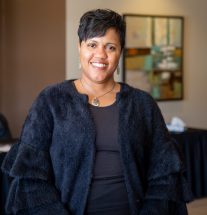In October of 2017, I changed my email autoreply to read, “I am responding daily to the needs of our students and staff and am not able to respond to emails or phone calls quickly. Thanks for your patience. I look forward to connecting with you. Regards, Angela.”
I take my role as an antiracist leader very seriously, and doing right by the students and staff in my care is nonnegotiable. To do that, I need to have time, space, and focus. In the time leading up to that change in my autoreply, I realized that being the go-to person for all conflicts and difficulties arising from difference was an unrealistic expectation that would keep me from devoting myself to students and staff.
The other reason I changed the autoreply was to protect my sanity, my peace, and my spirit of humility. In my work bridging differences, each day can be mentally and emotionally taxing. In the preceding months, I had supported principals in conflict with parents, central office directors in conflict with direct reports, and community members who were hurt and angry about executive leaders’ polarizing decisions about issues affecting LGBTQIA+ people. Now I was faced with racial incidents at high schools, one of which gained national attention. Because race is a taboo subject, especially in my state, which is one of the most racially polarized regions in the U.S., helping the community talk about it is as exhausting as it is essential and rewarding.
The value of community
As I faced all of these stressful situations, I knew I needed to reestablish my personal value of being in community. Working in community is a requirement for doing antiracist work. As I work with students, families, and staff, I push myself to evaluate what I can do from my sphere of influence, but I am honest with myself about my reach. I lean on a collective of likeminded people to support this important work, because we all have privileges that block our ability to see and feel the lived experiences of people who are different from us.
Being in community is also essential for self-care. After I updated my autoreply, I alerted my squad that I was tired. These colleagues and friends had my back and helped me navigate the difficulty ahead with the school communities. This strength helped me invite others from the school community into deep dialogue and reflection about the “why” for the racist incidents. As a black woman, I know that we must get at the root causes of racist incidents and take ownership. Otherwise, they will continue to happen.
In this case, adults had allowed racially offensive language, innuendo, and action to occur with indifference, and we as a community needed to address that and change it. I transferred to this work all the tools and strategies I learned as an instructional coach, engaging the adults in consciousness-raising activities to lead a shift in the ways of work. The first meetings with the leadership team were designed to develop collective responsibility for personal and campus wide learning to shift the future trajectory to proactive strategies for addressing racism head on. We operated as a collaborative, shouldering the full burden of supporting the massive student body and staff. We gathered personal accounts of how various stakeholders experienced the campus culture through small group meetings with all students and staff as well as families and community members. We shared our findings and crafted a schoolwide response to show the community that the racist incident was being taken seriously and that the adults were committed to doing better in the future to ensure the campus community did not return to the current state.
The path to self-care
Throughout this process, I took breaks, ate breakfast and lunch, took daily walks, and paced myself. I prioritized my mental, physical, spiritual, and emotional health. I chose to support the leadership for two days, then took off a few days, as planned, to celebrate my wedding anniversary. I chose to honor a late friend and colleague, who had felt she had no choice but to allow her work to consume her in a way that caused her physical health to suffer and took her away at the age of 52. I chose to step back, reevaluate my choices, and follow a path that was sustainable for me as an individual, mother, wife, daughter, friend, and educator advocating for children who have little or no voice in educational decisions.
My small shift in email communication was a step along that path, but not the only step. I encourage all of us to evaluate what steps we can take to support ourselves even as we support others. I encourage us to start by surfacing what’s important to us to support the children in our care. Then, act from that place and act on issues within your sphere of influence. Partner with others to limit your stress and tap into multiple perspectives.
''I encourage all of us to evaluate what steps we can take to support ourselves even as we support others.'' — Angela Ward (@2WardEquity) Share on XI also encourage educators to break down major issues and goals into manageable chunks. Be honest with yourself about the fact that you can’t change the whole system, and then ask yourself: what can you disrupt to make our schools safe, welcoming, and inclusive for those whose voices are not represented? Of those things, what is most important to you and what can you address first?
Honor yourself enough to choose self-care. The children deserve the best of you, and so do you and your loved ones. Take care.









